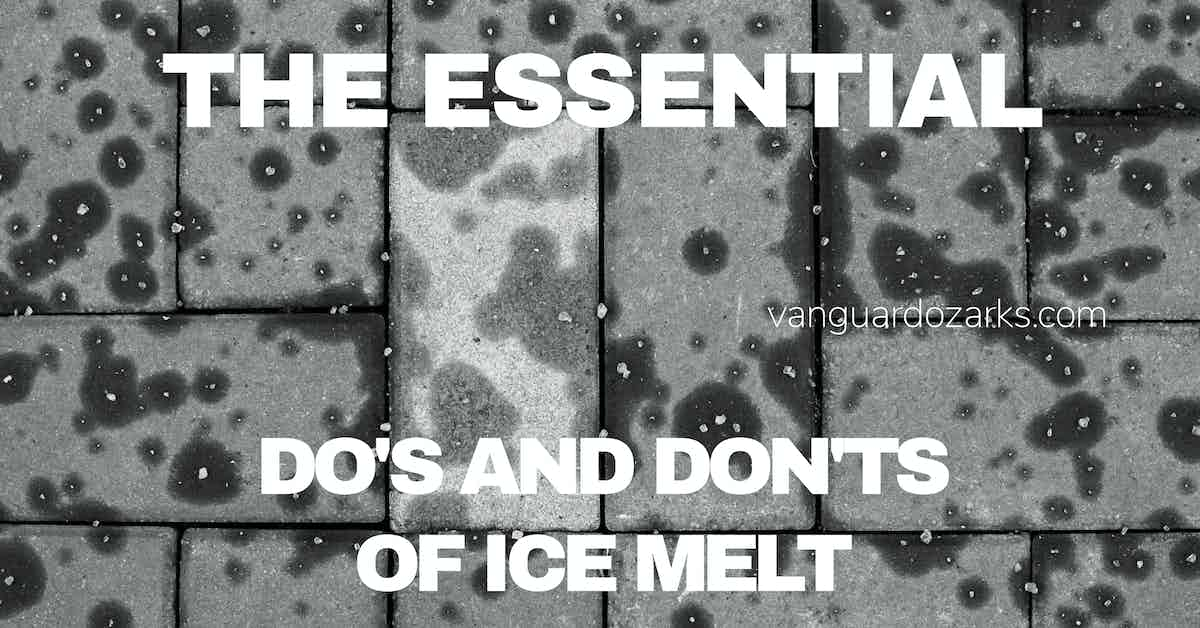Ice melt is a valuable tool for improving safety conditions and helping to prevent slip and fall accidents--but incorrect use and application can result in hazardous conditions and damage to the built environment, especially flooring.

What is Ice Melt, and How Does it Work?
Ice melt is a chemical compound used to melt ice and snow on surfaces such as sidewalks, driveways, and roads.
It works by lowering the freezing point of water so that the ice and snow melt faster, resulting in improved traction and safety for pedestrians.
Ice melt typically contains sodium chloride (rock salt) or calcium chloride, both salts that dissolve in water to form an electrolyte solution.
When this solution comes into contact with ice or snow, it draws in moisture and forms a liquid brine that spreads along the walkway's surface while generating heat.
The heat from the liquid brine breaks the bonds cementing the ice to the walkway surface, making it easy to sweep or shovel away.
Ice Melt Challenges
Ice melt and rock salt use pose several challenges that must be addressed to ensure safe product use.
- Salt rock and deicer can damage hard surfaces, such as concrete or metal, resulting in cracks and premature corrosion.
- Salt rock and deicer buildup can damage indoor carpeting, hard flooring, and upholstery.
- Overflow of rock salt and deicer can damage landscaping, pollute waterways, and harm wildlife, and;
- Using the wrong kind of product, applying it at the wrong time, or not using enough can result in suboptimal conditions and wasted resources.
Do's of Ice Melt - Tips to Ensure Maximum Safety & Efficiency
- Use the recommended ice melt for your region, as some solutions are better suited for specific climates and temperatures.
- Always follow the manufacturer's instructions for measuring and application.
- Apply the ice melt evenly and in a well-ventilated area to prevent inhalation.
- Wear personal protective equipment to prevent skin-to-deicer contact.
Don'ts of Ice Melt - Common Mistakes to Avoid
- Do not use ice melt on concrete that is less than one year old.
- Do not use too much ice melt, as it can damage surfaces, vegetation, and waterways.
- Do not use ice melt products that contain calcium chloride, as it can cause corrosion to metals and other surfaces.
- Do not use ice melt products that contain urea or ammonium nitrate, as they can damage vegetation and aquatic life.
- Do not leave ice melt on surfaces for extended periods, as it can cause staining and discoloration.
What are the Best Types of Ice Melt for Different Surfaces?
The best type of ice melt for different surfaces depends on the surface material, temperature, and weather.
- Calcium chloride or magnesium chloride (or a combination of both) is the most effective for concrete, asphalt, and brick.
- For metal surfaces, sodium chloride is the best choice.
Urea or potassium acetate is recommended for wood decks and other wooden surfaces. - For gravel surfaces, calcium magnesium acetate is the best option.
Lastly, calcium magnesium acetate is the safest choice for grass and other vegetation.
How to Properly Apply Ice Melt Around Your Business
Clear any snow or ice from the area that is to be treated before applying ice melt.
This will ensure the ice melt has direct contact with the ice and will prevent it from simply melting the snow and running off.
When possible, use a drop or hand crank spreader (similar to those used in landscaping) to distribute the ice melt evenly, and use a broom or rake to clear up any overspray.
And finally, increase the frequency and quality of cleaning around the primary entrances into the building to prevent any moisture accumulation from creating a slip hazard and any ice melt buildup from damaging the indoor built environment.
References & Resources
- Ice Melt Do's and Don'ts
- What is Ice Melt? Selecting The Best Ice Melt For Your Facility
- Ice Melt Is Ice Melt. Here's How to Use It.
- Ice Melt - How Does It Work?
Takeaway
The correct use of ice melt and rock salt can significantly improve the traction on slippery surfaces caused by snow and ice, thereby improving the safety and security of the people entering and leaving the building while reducing business risks.
However, incorrectly applying either product--which is all too easy to do--can result in significant damage to the physical property and potentially exacerbate slip and fall conditions.
Further, regardless of how the product is used, some residue will remain on occupant shoes and enter the building, where the ice melt will eventually damage the floor and furniture--the solution for which is to install high-performance entry and walkway matting while increasing floor maintenance and cleaning frequencies during the winter.
Unfortunately, onboarding and managing the requisite labor and material resources in the current market may prove cost-prohibitive and undesirable for many organizations.
Outsourcing is a proven method for onboarding skilled service providers equipped with the latest training, processes, and technologies for a fraction of the price of maintaining a comparable service in-house.
Contact us today and discover why Vanguard Cleaning Systems® is the Standard of Clean® for businesses throughout Northwest Arkansas, Missouri, and Oklahoma.
In Oklahoma, dial 918-960-4450
In Arkansas, dial 479-717-2410
In Missouri, dial 417-812-9777

